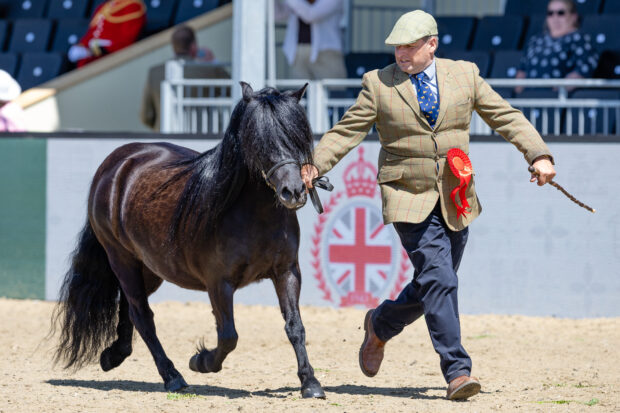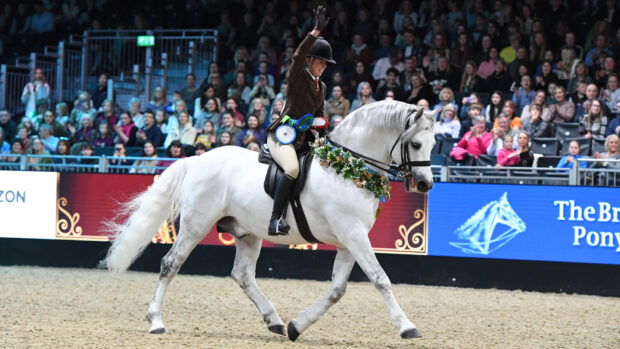National Pony Society chairman and leading judge Martin Jones on the quality of exhibits at Royal Windsor Horse Show, set shows and avoidable upsets
Judging the ridden mountain and moorland (M&M) classes at Royal Windsor Horse Show was a privilege, and I take my hat off to the team who had done a brilliant job in ensuring everything ran smoothly, the ring was in good order, and that we weren’t wallowing in mud.
My co-judge, Charlotte Miller, and I were on the same page throughout and we were both delighted with our champion (Castle Kestrel) and reserve (Westown Wild Fire); two lovely stallions who had stood out from the moment they entered the ring.
They were both pulled in top in their respective classes, had excellent conformation and breed type, and performed well. They both looked bright and exuded presence in the Castle Arena championship in the evening.
In the classes, Charlotte and I agreed to pull in between six and eight ponies after the go-round, as it’s important to recognise initial efforts – but we weren’t afraid to use our marks to move around the line-ups based on what we saw.
While each of our winners were deserving, there was a bit of a tail end in each class, as the standard of presentation, type and conformation dropped off towards the end of the line.
Numbers in each of the classes were down compared to when I judged the conformation section at Windsor a few years ago, which I feel is a sign of the times and is impacting all shows this season. The cost of living is hitting everyone hard and people who show as a hobby are making careful decisions about where they spend their money.
Why I chose a set show
I’m not always in favour of a set show – I value a situation where a rider can play to their animal’s strengths – but when you’re judging using marks it’s a good way of ensuring consistency.
I asked the combinations to walk away, trot then pick up canter on a straight line before cantering a large circle. It’s surprising how many riders, even at top level, rely on the corner to get the correct canter lead. Many riders left the transition until very late so they were practically cantering on the top corner, or veered off onto an angle to get the right leg. This lost people marks.
I then specified for a large circle in one half of the arena before performing an extension down the long side, followed by a change of rein through the centre line. When they passed the centre I requested four or five walk strides before another transition into canter.
Many struggled with the walk, as some ponies anticipated and jogged, while others almost fell into halt as though they were coming to the end of their show. Easy things to address at home with practice and training.
The final element after the second canter was a long stretch of trot back in front of the line-up before a walk and a halt. This section was key. I got to see some ponies at their best as riders were more relaxed as they came towards the end of their shows, and the ponies were relaxed approaching the line-up.
Hats, weight and four-year-olds
Unfortunately, we lost a handful of exhibitors at the gate as they arrived at the ring without having their hats tagged. I advise any competitors to check the rules ahead of a show, particularly at the start of the season when new rules come into force. It’s an expensive mistake to make and I’m sure that it made for a very disappointing experience.
I was happy to see most animals were in good condition. A few were carrying too much weight though, and this was reflected in our marks.
In the past I’ve been concerned about the number of four-year-old ponies competing in open classes so early in the season, but this year we were only presented with one to judge. I always ask how old a pony is when I’m judging as it gives an indication of its level of training and experience.
It’s a lot to expect any young pony to compete at this type of show in open classes and I encourage competitors to get mileage with their ponies first, by aiming them at novice classes, particularly in their first season.
● Do you prefer riding a set show or would you rather have your own freestyle performance? Write to us at hhletters@futurenet.com, including your name, nearest town and country, for the chance to have your views published in a future issue of Horse & Hound magazine.
- This exclusive column will also be available to read in Horse & Hound magazine, on sale Thursday 25 May, 2023
You may also be interested in…

Royal Windsor judge Sarah Kate Coward: fit not fat – and why first impressions matter

37 wonderful show ring winners snapped at the 2023 Royal Windsor Horse Show

‘She is pony obsessed’: first Windsor victory for top showing family’s youngest member

Subscribe to Horse & Hound magazine today – and enjoy unlimited website access all year round
Horse & Hound magazine, out every Thursday, is packed with all the latest news and reports, as well as interviews, specials, nostalgia, vet and training advice. Find how you can enjoy the magazine delivered to your door every week, plus options to upgrade your subscription to access our online service that brings you breaking news and reports as well as other benefits.




